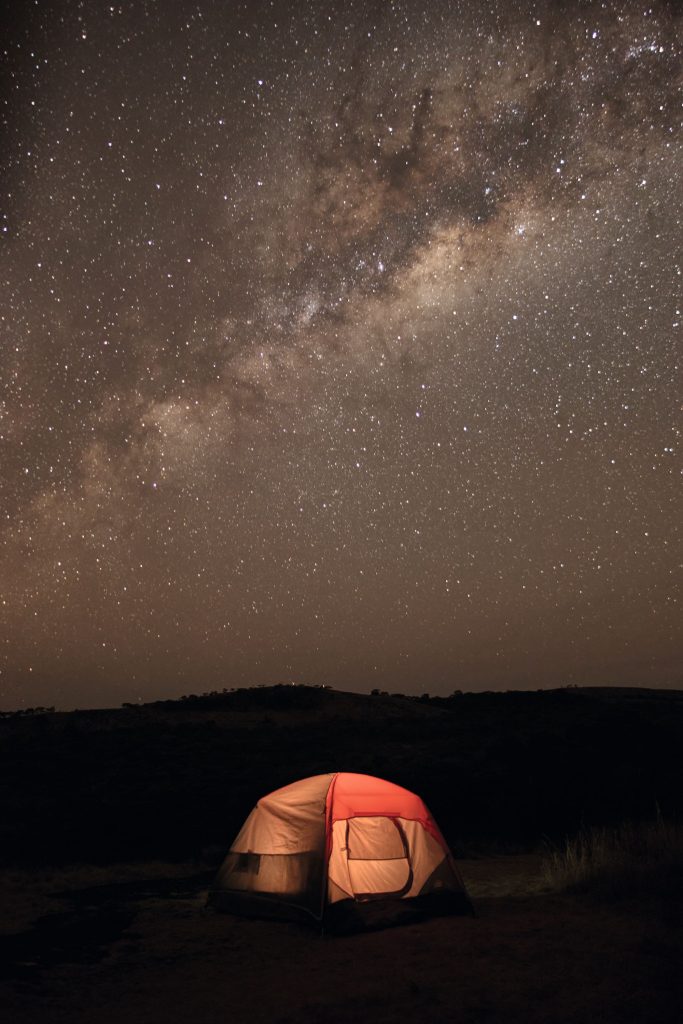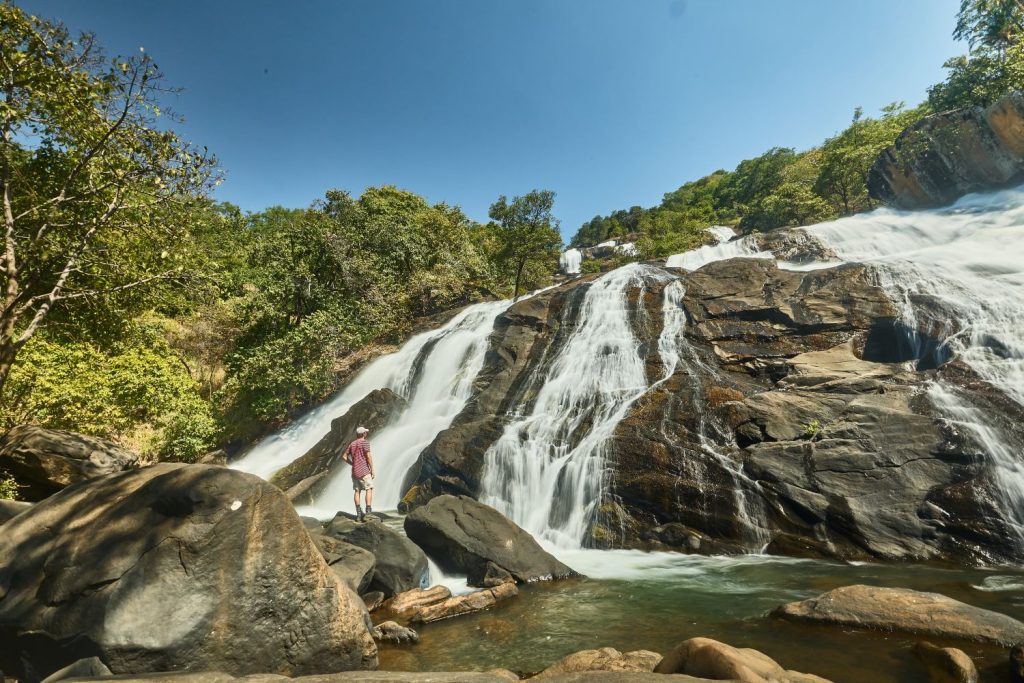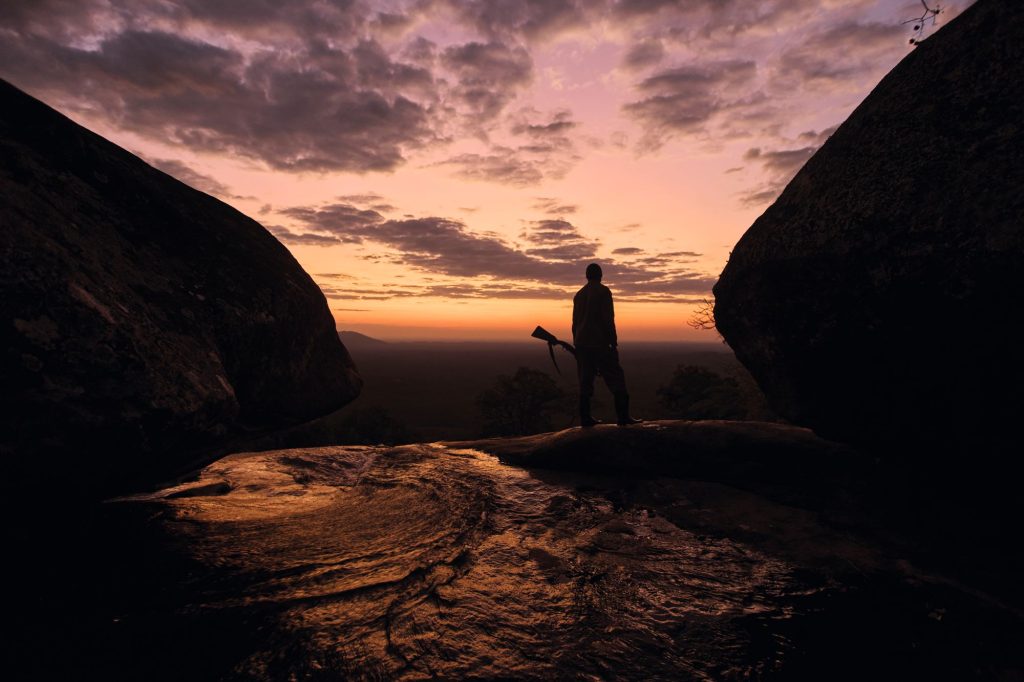Between Sky and Water
The water was cold. Like it had been brewing in the dark, damp belly of the mountain all night long. The bright winter sun and the crisp morning air attending to it had little effect on the water, except maybe in the quick change of hue from white-blue to blue-green as it cascaded down the waterfalls and into rock pools.
Walid and I were the first to get down to the pool. Walid, an avid hiker, shared my enthusiasm for exploring uncharted territories. Moses, our seasoned guide, was not far behind, his keen eyes scanning the surroundings for any signs of wildlife. Adriaan, our photographer with a knack for capturing the beauty in the mundane, was last, meticulously taking photographs of all sorts of things whilst descending the steep decline and the river that followed it. We had half-expected to find a place to swim, knowing we’d be worn down and sticky after a morning’s hike. It was a pool about fifteen metres wide and ten metres long. It is not deep, just under two metres at its deepest, calm from the pebble floor to the blue-green surface. But I imagine this pool overflows with water during the height of the rainy season, accommodated by the wide riverbeds of granite rock.

We took turns guessing the temperature. “Below ten?” I ventured, biting the end of my words as soon as they left my mouth. I knew I shot too low, but it felt cold enough after hiking down the escarpment for the better part of an hour. We settled on somewhere near fifteen, give or take a couple of degrees. Our bodies soon adjusted to it.
Pre-historic rock paintings and fragments of baTwa and Bisa are dotted around the reserve.
Mutinondo Wilderness is a sprawling 10,000-hectare nature reserve ‘off the beaten path’, about 360 kilometres north of Mkushi. Mutinondo Wilderness is where raw, pristine wilderness and a serene camping experience come together. No doubt this is what I was promised, but they might have forgotten to mention the hiking. Mutinondo Wilderness is best known for its remoteness, unique landmass, and pristine rivers, but not so much for its thriving wildlife. Mutinondo Wilderness invites the adventurer to hike its diverse Miombo woodlands, swim or canoe its crystal-clear rivers, spot hundreds of species of birds or watch the night roll into the day under an unpolluted sky, providing an ideal setting for those (me) seeking solace and adventure in equal measure.

We were hiking down the Muchinga Escarpment, which separates the plateau from the South Luangwa National Park. We had started the previous day, parking at the escarpment’s edge and hiking down to ‘Quentin’s Place’. It took us about an hour and a half to get down, at times at a 45-degree angle (or, at least, that’s what it felt like). It was apt preparation for the hiking to come. It either breaks or mends your knees and, at times, your spirits.
Quentin’s Place is a small clearing a dozen metres from the Mutinondo River, the primary river flowing through the Mutinondo Wilderness, an hour and a half by car. The unassuming clearing begins to give a sense of the scale of this wilderness. After dropping our packs, which were too heavy under normal circumstances, we went to the river, which had a moderate amount of water flowing through large boulders. Immediately, we looked out across the wilderness, an immensely satisfying panorama that had been teasing us through the trees as we trekked down the escarpment. It was a sight reminiscent of Mutinondo’s highest peak, called Mayense, which we had summited earlier that day.

Mayense is a granite ‘inselberg’ (an isolated hill or mountain rising abruptly from a plain), probably better known as a koppie in Southern Africa. It is about 240m above the surrounding plateau and 1684m above sea level. The geological formation of these granite koppies is complex. Still, it is part of a much larger formation called the Irumide Belt, running some 900 kilometres from central Zambia to the Tanzanian border. Mayense best resembles a very large mound that rises unexpectedly out of the earth. Another, such as the ‘Caterpillar’, is named so in reference to its wavy, rolling spine. There are at least ten peaks at Mutinondo worth a mention.
From the top of Mayense, we looked out across the vast expanse of the savannah woodland, a horizon broken by the regular controlled fire in the distance and the odd dambo (seasonal wetlands found in central and southern Africa). Most natural features in Mutinondo and its surrounding areas are named — for example, Mayense was named after the man whose vehicle broke down at its foot. Others are called after the friends and family of the previous owners (such as Quentin Allen), others after animals like Hyrax Hill, where we visited faint rock paintings by the baTwa, probably thousands of years old. Along with the incredibly rich and detailed study of Mutinondo’s fauna, flora and archaeology, the naming of these sites suggests that the building and maintaining of Mutinondo has been a labour of love.
Various archaeological and anthropological finds have been made in and around Mutindo.
That night, after we cooked dinner over the open fire, we went out and climbed the boulders above the Mutinondo River and looked at the stars. The moon was hidden, and the stars slowly became brilliant: we watched as the sky turned from nightfall with specks of stardust to the Milky Way as it streaked across the quiet night sky. We had watched stars the night before, sitting on Camper’s Rock near the main camp. Adriaan had set up the camera so we could photograph the stars’ movements, and as we waited, we saw a blue streak of light passing to our left before we heard a dull thud. We were convinced it was a meteorite landing on earth.
Moses had a fire burning all night, by which we all slept—he in the open and us in a tent. With over two decades of experience in Mutinondo, he moved with the confidence and ease of someone deeply familiar with the wilderness. We slept warmly by the fire, a considerable difference from our first night at Mutinondo, where the cold bit at our bones. After a good night’s sleep, we headed out early to hike further down the escarpment. Moses had promised us more waterfalls. We had seen one the day before—’Cheswa Falls’, cheswa meaning broom. Long and thin with a wider cascade at its end, it was an apt name, and that morning, we tried hiking upstream along the riverbed to its base, but without success. The path was too dangerous.

Instead, we headed downstream, with the rush of the water always within earshot. After fifteen minutes, we reached Quentin’s Falls, a vast and powerful waterfall overlooking enormous sprawling boulders. What it had in scale, it lacked in intimacy, something that the smaller Mutinondo Falls, another twenty-five minutes further down, boasted. The water spray cooled us off before we could get to the water’s edge.
Below Mutinondo Falls are a series of rapids, small falls, and rock pools, which we decided to explore. We found the rock pool, which we eventually swam. There was little stopping our intrepid spirits, apart from the vague sense of time hanging over us. Whilst Walid, Adriaan and I exhibited something akin to a childlike curiosity, Moses was like the patient parent watching over us. He climbed up and down the mountain, barely breaking a sweat, and always carried a shotgun with him, ostensibly for our safety.
The ‘inselbergs’ are an exposed Irumide belt, billions of years old, that stretches to Tanzania. East of the belt is the Muchinga Escarpment.
“Have you ever used it?” Walid asked, motioning towards the Mossberg Maverick slung over Moses’ shoulder. He carried it casually, as expected of someone who’d been at it for two decades. “No,” he responded, perhaps unsure of what was asked. In March of this year, two lions had been spotted on Camper’s Rock, where we enjoyed our evening of stargazing. A rare occurrence, Kyla—one of two new managers (the other being her husband David)—assured us: “Twice in twenty-five years”. But the night we were on Camper’s Hill, we heard the distinctive gulping of the lion, followed by the bark of a bushbuck. A lion was still in the area.

Mutinondo prides itself on a delicate balancing act – between raw wilderness and tame camping. Wild animals are only one aspect of an ecosystem that Mutinondo’s management has worked hard to keep intact on its property. We saw warthogs with squat build and bristly manes rooting around for food with surprising vigour. Baboons, still as sages, surveyed us with watchful eyes, occasionally letting out a bark to communicate with their troop. With their delicate, precise movements, Klipspringers bounded gracefully across rocky outcrops, displaying incredible agility. A solitary jackal moved stealthily through the underbrush, its ears perked and nose twitching, ever alert for signs of prey or danger. A water monitor lizard, its sleek body glistening in the early morning sun, basked near the river. We also noticed animal burrows and various droppings, each a sign of the thriving wildlife. Despite these sightings, we never once felt threatened. The natural environment is superbly intact, with our hikes cutting across virgin land. Other folk, finding canoes at the water’s edge near Paradise Pools, would find the smaller Musamfushi River—which joins the Mutinondo River at a confluence—similarly idyllic, the only movement being the insects as they flee from the canoe’s bow as it cut upstream.
Mutinondo Wilderness is a birder’s paradise and is listed as an Important Bird Area, with over 350 recorded species, including rare species such as the Bar-Winged Weaver.
The ability to act freely was a gift, especially in the wild, where there is always a hidden tension between nature and humans. Of course, this ‘gift’ is always contingent—contingent on Moses and his shotgun, contingent on humans cohabiting with each other peacefully, and contingent on our ability to protect the environment.
Returning from Mutinondo was a mix of relief and longing. The comforts of home would welcome me, but the rugged, untamed beauty of the wilderness would leave behind an ache. To me, this was a wilderness, nature’s gift to its faithful, a just reward for toil: its cold mountain waters, the vast starry skies, the solitude. Well, that’s what I told myself as I prepared for the long hike back up the escarpment.
Mutinondo is also home to the world’s largest edible mushroom, Termitomyces titanicus,or chingulungulu, which can reach up to one metre in diameter.




